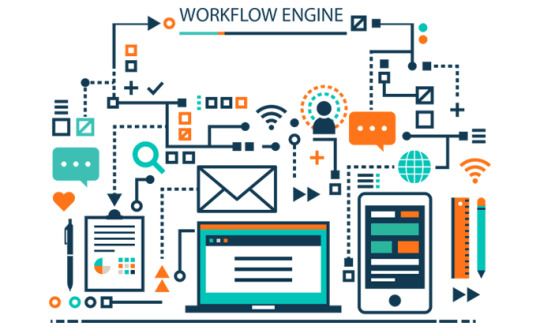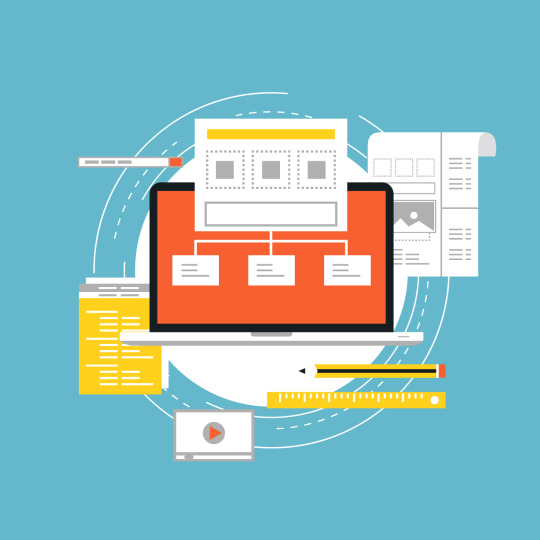#workflowengine
Explore tagged Tumblr posts
Text
Effortless Excellence: Your Guide to Cutting-Edge Automation Tools
Automation has become a cornerstone for achieving excellence in modern business operations. This guide to automation tools, providing a comprehensive roadmap for organizations seeking to effortlessly enhance their efficiency and productivity.

The Evolution of Automation: Start by tracing the evolution of automation in business processes. Explore how automation has transitioned from simple repetitive tasks to sophisticated, end-to-end process optimization.
Understanding Cutting-Edge Automation Tools: Provide an overview of the latest and most advanced automation tools available in the market. From robotic process automation (RPA) to intelligent automation powered by artificial intelligence, explore the breadth of cutting-edge solutions.
Integration with Artificial Intelligence: Delve into the synergy between automation and artificial intelligence. Discuss how AI-driven automation tools can analyze data, make intelligent decisions, and adapt to dynamic business environments.
Benefits of Cutting-Edge Automation: Examine the tangible benefits organizations can reap by adopting cutting-edge automation tools. From cost savings and error reduction to enhanced scalability and improved customer experiences, explore the transformative power of these tools.
Implementing Automation: A Step-by-Step Guide: Guide readers through the process of implementing automation in their organizations. Provide a step-by-step roadmap, covering aspects such as identifying automation opportunities, selecting the right tools, and ensuring a smooth transition.
Overcoming Challenges in Automation Adoption: Acknowledge common challenges organizations may face during the adoption of cutting-edge automation. Discuss strategies for overcoming resistance, addressing integration issues, and ensuring a positive impact on the workforce.
Security Considerations in Automation: With increased automation comes a heightened need for cybersecurity. Explore best practices for ensuring the security of automated processes, protecting sensitive data, and mitigating risks associated with advanced automation tools.
Real-world Success Stories: Share success stories of organizations that have achieved effortless excellence through the strategic implementation of cutting-edge automation tools. Highlight specific challenges they faced and how these tools played a pivotal role in overcoming them.
Continuous Improvement in Automation: Automation is an ongoing journey. Discuss strategies for continuous improvement, including regular evaluations, feedback loops, and staying abreast of emerging technologies in the automation landscape.
Future Horizons of Automation: Explore the future horizons of automation, from the integration of quantum computing to the potential impact of automation on job roles. Provide insights into how organizations can prepare for the next wave of advancements in automation technologies.
youtube
SITES WE SUPPORT
Workflow Talent Tool – Wix
#workflowmanagementsystem#workflowautomationtools#workflowengine#candidateassessmenttools#candidatetalentassessmenttools#Youtube
0 notes
Text
Efficiency Unleashed: Mastering Workflows with a Cutting-Edge Engine
In the dynamic realm of business operations, mastering workflows is synonymous with unleashing efficiency. This blog is your guide to using workflow engines, revolutionizing the way your organization operates and propelling it toward unparalleled efficiency.

Demystifying Workflow Engines: Understanding the core concepts of workflow engines is the first step toward mastery. We'll delve into the intricacies of how these engines automate processes, eliminate redundancies, and streamline communication, providing a foundation for the transformative power they hold.
Versatility in Action: Workflow engines are versatile, adapting to various industries and organizational structures. This section explores real-world examples, showcasing how organizations across sectors have leveraged workflow engines to optimize diverse processes, from project management to customer onboarding.
Strategic Implementation: Implementing a workflow engine is not a one-size-fits-all endeavor. We'll discuss strategic approaches to implementation, including assessing organizational needs, selecting the right engine, and ensuring seamless integration with existing systems for a smooth transition.
Enhancing Collaboration: Efficient workflows hinge on effective collaboration. We'll explore how cutting-edge workflow engines facilitate collaboration among team members, departments, and even external stakeholders, breaking down silos and fostering a culture of seamless communication.
Integration with Emerging Technologies: The world of technology is ever-evolving, and workflow engines are no exception. We'll discuss how these engines integrate with emerging technologies like artificial intelligence and machine learning, opening new frontiers for automation and predictive analytics.
Customization for Organizational Dynamics: Every organization is unique, and workflow engines should align with its specific dynamics. We'll delve into the importance of customization, allowing organizations to tailor workflow engines to their processes, ensuring a perfect fit for maximum efficiency.
Measuring Efficiency Gains: Quantifying the impact of workflow engines is essential for demonstrating their value. We'll explore key performance indicators (KPIs) and metrics that organizations can use to measure efficiency gains, providing tangible insights into the transformative power of workflow engines.
Adaptability in the Face of Change: In a rapidly changing business landscape, adaptability is crucial. We'll discuss how workflow engines empower organizations to adapt to changes efficiently, whether it's scaling operations, accommodating new processes, or responding to shifts in market dynamics.
Future Trends in Workflow Technology: Looking ahead, we'll explore emerging trends in workflow technology, providing insights into how these tools are likely to evolve and shape the future of organizational efficiency.
Conclusion: Efficiency unleashed through mastering workflows is not just a goal; it's a journey toward organizational excellence. By demystifying workflow engines, strategically implementing them, enhancing collaboration, embracing customization, and staying abreast of emerging trends, your organization can unlock unprecedented efficiency and pave the way for future success.
youtube
SITES WE SUPPORT
Modeling Process Test – Wix
#expenseapprovalprocess#workflowengine#businessprocessmodeling#preemploymentassessmenttests#candidateassessmenttools#Youtube
0 notes
Text
Workflow Engine Unleashed: Turbocharge Your Workflows
Building on the concept of workflow engines, this blog delves deeper into the subject, exploring how to truly unleash the importance of workflow engine to turbocharge your business processes.

Advanced Workflow Engine Features: We'll discuss advanced features and capabilities of workflow engines that can supercharge your workflows, such as conditional routing and dynamic task assignments.
Case Studies: Explore real-world case studies of organizations that have successfully implemented advanced workflow engines for remarkable results.
Customization and Integration: Discover how you can customize a workflow engine to fit your unique business needs and seamlessly integrate it with your existing software and systems.
Scalability and Efficiency: Learn how a well-implemented workflow engine can handle increased workloads and scale your processes efficiently.
Best Practices: We'll share best practices for harnessing the full potential of a workflow engine to achieve maximum efficiency.
youtube
SITES WE SUPPORT
Workflow Model KPIs – Wix
#workflowmodel#workflowengine#accountspayableworkflowprocess#recruitingkpis#preemploymentaccountingassessment#Youtube
0 notes
Text
Navigating Complexity: The Magic of a Workflow Engine
Workflow engines are like magicians in the world of process automation. They are the magic behind simplifying complex operation using workflow engine and making sure everything runs smoothly, no matter how intricate the process may be.

Complex processes, such as order fulfillment in e-commerce, insurance claims processing, or healthcare patient management, require a robust workflow engine to orchestrate tasks, enforce business rules, and ensure compliance. These engines are responsible for routing tasks to the right individuals or systems, tracking progress, and making decisions based on predefined rules.
Some popular workflow engines include Apache Camel, Camunda, and Bizagi. These tools offer a range of features, including process modeling, real-time monitoring, and integration with various data sources.
Workflow engines are essential for businesses dealing with intricate processes, as they bring order and automation to what might otherwise be a chaotic and error-prone endeavor. By navigating complexity with the magic of a workflow engine, organizations can optimize their operations, reduce costs, and deliver consistent and reliable services.
youtube
SITES WE SUPPORT
No Code Platform Tools – Blogspot
#workflowmanagementtools#workflowengine#nocodeworkflowplatform#candidateassessmenttools#pre-employmentassessment#Youtube
0 notes
Text
Automation Nation: Mastering Efficiency with the Best Tools
Welcome to the Automation Nation! In this blog, we'll take a journey through the world of automation tools and how they can help you master efficiency, reduce manual work, and propel your organization forward.

The Rise of Automation: Automation has transformed industries by minimizing human intervention and maximizing productivity. It encompasses a wide array of tools and technologies designed to streamline tasks and processes.
Exploring Automation Tools:
Robotic Process Automation (RPA): Discover how RPA bots can handle repetitive tasks with precision. Artificial Intelligence (AI) and Machine Learning (ML): Learn how AI and ML can make data-driven decisions and predictions. Workflow Automation Software: Explore platforms that automate complex business processes. Chatbots and Virtual Assistants: Understand how these tools enhance customer support and engagement. Benefits of Automation:
Time and Cost Savings Reduced Errors Enhanced Customer Experience Improved Data Accuracy Scalability Industry Applications: Explore how various industries, from finance to healthcare, are harnessing automation to stay competitive and meet evolving demands.
Case Studies: Dive into real-life examples of organizations that have embraced automation and reaped the rewards of increased efficiency.
youtube
Conclusion: Automation is the driving force behind the future of business. By joining the Automation Nation, you can master efficiency, streamline operations, and propel your organization to new heights.
SITES WE SUPPORT
Workflow Engine Tools – Blogspot
#workflowmanagementsystem#workflowautomationtools#workflowengine#candidateassessmenttools#candidatetalentassessmenttools#Youtube
0 notes
Text
Boosting Efficiency and Productivity: How a Workflow Engine Can Transform Your Workflows
Efficiency and productivity are the lifeblood of any successful organization. In today's fast-paced business landscape, companies are constantly seeking ways to optimize their workflows and maximize output. One transformative solution that has gained significant traction in recent years is the use of workflow engines. These powerful tools can streamline processes, reduce manual work, and enhance collaboration among teams. In this blog, we'll delve into how a workflow engine can revolutionize your workflows, boosting efficiency and productivity to new heights.

Understanding Workflow Engines
Before we explore the benefits of workflow engines, let's define what they are. A workflow engine is a software application designed to automate, manage, and monitor a sequence of tasks or processes within an organization. It serves as the backbone of your workflows, ensuring that tasks are executed systematically and efficiently.
Now, let's dive into how a workflow engine can transform your workflows:
Eliminating Manual Tasks
One of the most significant advantages of a workflow engine is its ability to automate repetitive and manual tasks. Think of the countless hours employees spend on data entry, email notifications, and document approvals. A workflow engine takes over these tasks, allowing your workforce to focus on more creative and strategic responsibilities. This reduction in manual work not only saves time but also reduces the risk of errors.
Enhancing Process Consistency
Consistency is key to delivering high-quality products or services. Workflow engines enforce standardized processes, ensuring that tasks are completed in the same way every time. This consistency not only improves the quality of your outputs but also enhances customer satisfaction.
Real-time Monitoring and Reporting
With a workflow engine, you gain real-time visibility into the progress of your workflows. You can track the status of individual tasks, identify bottlenecks, and measure performance metrics. This data-driven approach empowers you to make informed decisions and continuously optimize your processes.
Streamlining Complex Workflows
Many organizations have workflows that involve multiple steps, departments, and stakeholders. Managing such workflows manually can be a daunting task. A workflow engine simplifies this complexity by automating the flow of tasks, ensuring they are completed in the correct sequence and notifying the relevant parties when their input is needed.
Improved Collaboration
Collaboration is essential for project success, especially in today's remote and globally dispersed work environments. Workflow engines often come with built-in collaboration features that allow team members to communicate, share files, and provide feedback within the context of a workflow. This not only saves time but also fosters better teamwork.
Scalability and Adaptability
As your business grows, your workflows may become more complex, and your workload may increase. Workflow engines are scalable and adaptable, making it easy to accommodate changes in your organization's size and needs. Whether you have ten employees or a thousand, a workflow engine can scale with your business.
youtube
Conclusion
In an era where efficiency and productivity are paramount, a workflow engine can be a game-changer for your organization. By automating tasks, ensuring consistency, providing real-time insights, and fostering collaboration, these tools can transform your workflows from time-consuming and error-prone processes into well-oiled machines.
If you're looking to boost efficiency and productivity in your organization, it's time to consider the advantages of a workflow engine. Embracing this technology can lead to reduced costs, improved customer satisfaction, and a competitive edge in your industry. So, start exploring your options and embark on the journey of workflow transformation today. Your business's success may depend on it.
SITES WE SUPPORT
Best Workflow Tools – Wix
1 note
·
View note
Text
Streamlining Operations: Workflow Engines vs. Business Rules Engines – Which Is Right for You?
In today's rapidly evolving business landscape, efficiency and agility are paramount. To stay competitive, organizations need to optimize their operations, reduce manual work, and ensure consistency in decision-making. Workflow Engines and Business Rules Engines are two powerful tools that can help achieve these goals. But how do you decide which one is the right fit for your specific needs? In this blog, we'll take a close look at both options to help you make an informed decision.

The Role of Workflow Engines
The workflow engines are designed to streamline and automate processes within an organization. They serve as the orchestrators of tasks, ensuring that work moves seamlessly from one step to the next. Here are some key features of Workflow Engines:
Process Automation: Workflow Engines excel at automating sequential and parallel processes. They are ideal for managing complex workflows with multiple steps and dependencies.
Customization: These engines provide flexibility in designing workflows, allowing you to define custom logic, rules, and conditions. This makes them versatile and adaptable to various industries and use cases.
Integration: Workflow Engines often come equipped with integration capabilities, enabling them to connect with a wide range of systems, databases, and APIs. This integration ensures that data flows smoothly and minimizes manual data entry.
Monitoring and Analytics: They offer comprehensive monitoring and reporting tools, enabling you to track the progress of workflows, identify bottlenecks, and make data-driven decisions for process improvements.
The Power of Business Rules Engines
Business Rules Engines, on the other hand, are designed to manage decision logic and enforce business rules consistently across applications and systems. Here's what you need to know about them:
Rule-Based Logic: Business Rules Engines specialize in managing complex business rules and decision-making processes. They are particularly useful when you need to ensure that the same rules are applied consistently throughout your organization.
Agility: These engines empower business users to define and modify rules without IT intervention. This agility is crucial in dynamic business environments where rules may change frequently.
Scalability: Business Rules Engines can handle a large number of rules and conditions, making them suitable for industries like finance, insurance, and healthcare, where compliance and regulations play a significant role.
Integration: While they can integrate with various systems, the primary focus of Business Rules Engines is on rule execution rather than process orchestration.
Choosing the Right Tool for Your Business
Now that we've explored the capabilities of both Workflow Engines and Business Rules Engines, let's discuss how to determine which one is right for your organization:
Identify Your Needs: Start by understanding your organization's specific requirements. Do you need to automate complex processes with multiple steps and dependencies (Workflow Engine), or is your main focus on enforcing and managing business rules consistently (Business Rules Engine)?
Consider Integration: Evaluate your existing IT infrastructure and assess the level of integration required. If seamless integration with various systems is a priority, both engines offer capabilities, but Workflow Engines may have an advantage.
Scalability and Flexibility: If your business rules change frequently or you need to manage a large number of rules, a Business Rules Engine might be the better choice. However, if process orchestration and optimization are crucial, a Workflow Engine should be your focus.
User-Friendliness: Consider who will be managing and configuring the engine. If your business users need to define and modify rules frequently, a Business Rules Engine with a user-friendly interface may be preferable.
Budget and ROI: Evaluate the costs associated with each option and assess the potential return on investment. Consider factors such as licensing, implementation, training, and ongoing maintenance.
youtube
In conclusion, both Workflow Engines and Business Rules Engines are valuable tools for streamlining operations and improving efficiency. The right choice depends on your organization's specific needs, integration requirements, scalability, and the level of control your business users require. By making an informed decision, you can enhance your operational efficiency, reduce manual work, and achieve a higher level of consistency in decision-making.
SITES WE SUPPORT
Capex Approval Process – Wix
1 note
·
View note
Text
Navigating Complexity: How a Workflow Engine Simplifies and Enhances Business Processes
In the intricate landscape of modern business, complexity can act as a roadblock to efficiency. As organizations grow and evolve, the challenges of managing complex workflows, approvals, and tasks can become overwhelming. However, there's a navigational tool that can transform complexity into clarity and streamline operations—enter the Workflow Engine. In this blog, we'll explore how a Workflow Engine can simplify your business processes, leading to enhanced efficiency and effectiveness.

Demystifying the Workflow Engine
Think of a Workflow Engine as your organizational GPS, guiding you through the twists and turns of business processes. It's a software solution that automates, manages, and optimizes tasks, approvals, and data flow across your organization. By defining a set of rules and sequences, a Workflow Engine automates processes, ensuring that they are executed consistently and efficiently.
Simplification through Automation
Effortless Task Management:
In a world of emails, spreadsheets, and manual hand-offs, tasks can easily fall through the cracks. A Workflow Engine brings order to chaos by automating task assignments, notifications, and escalations. This eliminates the need for constant follow-ups and ensures that tasks are completed in a timely manner.
Streamlined Approvals:
Approval processes can be convoluted, involving multiple stakeholders and numerous rounds of review. A Workflow Engine simplifies this by automating approval workflows. Whether it's procurement, project sign-offs, or document reviews, the engine ensures that approvals follow a consistent and predefined path.
Data Flow Harmonization:
Data moves through various stages in an organization, from entry to processing to reporting. A Workflow Engine ensures that data follows a predefined route, reducing the risk of errors and discrepancies. This leads to cleaner data, improved accuracy, and more reliable reporting.
Enhancing Efficiency and Collaboration
Increased Speed and Accuracy:
Manual processes are prone to errors and delays. A Workflow Engine minimizes these issues by automating repetitive tasks, leading to faster execution and higher accuracy. This not only saves time but also boosts overall productivity.
Consistency and Standardization:
In a diverse business environment, maintaining consistency is a challenge. A Workflow Engine enforces standardized processes, reducing variations and ensuring that every task is performed according to best practices.
Collaboration Amplified:
Cross-departmental collaboration can be hindered by communication barriers and siloed workflows. A Workflow Engine promotes collaboration by providing a centralized platform where teams can work together seamlessly, sharing information and completing tasks more efficiently.
Adaptability to Change:
As your business evolves, processes need to adapt. A Workflow Engine is agile, allowing you to modify workflows as needed without the need for extensive IT involvement. This ensures your processes remain relevant and efficient in a rapidly changing environment.
youtube
Conclusion
Navigating complexity in business processes requires a strategic approach, and a Workflow Engine is your guiding compass. By automating tasks, streamlining approvals, and harmonizing data flow, a Workflow Engine simplifies your operations, making them more efficient and effective. As you embrace this transformative tool, you'll find yourself navigating through complexity with ease, unlocking new levels of productivity and enabling your organization to thrive in the ever-evolving business landscape. With a Workflow Engine as your navigator, the journey through complexity becomes a journey towards growth and success.
SITES WE SUPPORT
Workflow BPM Software – Wix
1 note
·
View note
Text
Efficiency Unleashed: Harnessing the Power of a Workflow Engine
Introduction
In the world of business operations, efficiency is the key to success. Organizations constantly seek ways to optimize their processes, reduce bottlenecks, and improve overall productivity. This pursuit of efficiency has led to the rise of workflow engines—an innovative solution that empowers businesses to streamline their operations, automate repetitive tasks, and unlock new levels of productivity. In this blog, we'll explore the concept of a workflow engine, delve into its benefits, and showcase how it can revolutionize the way businesses operate.

Understanding the Workflow Engine
At its core, a workflow engine is a technology that automates and manages the flow of tasks, data, and documents within an organization's processes. It enables businesses to define, execute, and monitor workflows—sequences of tasks and actions—ensuring that processes are executed consistently, efficiently, and with minimal manual intervention.
The Benefits of a Workflow Engine
Streamlined Processes: A workflow engine allows businesses to map out their processes visually and automate each step. This streamlines operations, reduces human errors, and accelerates task completion.
Efficient Task Allocation: With predefined workflows, tasks are automatically assigned to the right individuals or teams, eliminating delays and confusion related to task ownership.
Consistency and Compliance: Workflow engines ensure that processes are executed consistently according to predefined rules, enhancing compliance and reducing the risk of errors.
Reduced Bottlenecks: By automating task assignments and approvals, workflow engines eliminate bottlenecks that often arise from manual handoffs and approvals.
Enhanced Visibility: Real-time monitoring of workflows provides clear visibility into the progress of tasks and allows stakeholders to identify and address any delays or issues promptly.
Data-Driven Insights: Workflow engines generate valuable data about process performance, bottlenecks, and completion times. These insights enable data-driven decision-making for continuous improvement.
Transforming Business Operations
Implementing a workflow engine isn't just about technology—it's about transforming how business operations are executed. Here's how you can harness the power of a workflow engine for your organization:
1. Define Your Processes: Identify key processes that could benefit from automation. Document the steps, roles, and decision points within each process.
2. Choose the Right Solution: Research and select a workflow engine solution that aligns with your organization's needs, integrates with existing systems, and offers the flexibility to customize workflows.
3. Design and Automate Workflows: Use the workflow engine to design workflows visually. Define task sequences, conditions, and rules for automated task assignments and approvals.
4. Implement and Train: Roll out the workflow engine across relevant departments and provide comprehensive training to ensure smooth adoption.
5. Monitor and Optimize: Regularly monitor the performance of automated workflows. Use the data and insights generated to identify areas for optimization and enhancement.
youtube
Conclusion
In the pursuit of efficiency, a workflow engine emerges as a transformative tool that empowers organizations to operate with unprecedented agility and productivity. By automating tasks, streamlining processes, and ensuring consistent execution, businesses can unleash their true potential and focus on innovation and growth. Embrace the power of a workflow engine, and you'll find yourself at the forefront of a new era of operational excellence, where efficiency is not just a goal but a sustainable reality.
SITES WE SUPPORT
Automatic Workflow Process – Wix
1 note
·
View note
Text
Efficiency Unleashed: The Ultimate Guide to Workflow Management
Efficiency is the cornerstone of success in any organization, and effective workflow management sustem is the key to achieving it. This comprehensive guide explores the principles, strategies, and tools needed to unleash efficiency within your workflows.

Foundations of Workflow Management: Begin by establishing a solid understanding of what workflow management entails. Define key concepts, such as processes, tasks, and roles, and emphasize the importance of aligning workflows with organizational goals.
The Importance of Clear Process Documentation: Guide readers through the process of documenting workflows clearly and comprehensively. Discuss how having a detailed map of processes fosters transparency, accountability, and effective communication within teams.
Strategies for Streamlining Workflows: Delve into proven strategies for streamlining workflows, including automation, task prioritization, and resource optimization. Highlight case studies to illustrate how organizations have successfully implemented these strategies.
Choosing the Right Workflow Management System: Explore the landscape of workflow management systems and guide readers in selecting the right one for their organization. Consider factors such as scalability, integration capabilities, and user-friendliness.
Collaboration and Communication in Workflow Management: Examine the critical role of collaboration and communication in effective workflow management. Discuss tools and techniques that facilitate seamless communication among team members and across departments.
Agile Workflow Practices: Introduce agile principles and how they can be applied to workflow management. Discuss the benefits of adaptability, continuous improvement, and quick response times in the face of evolving business requirements.
Workflow Analytics for Continuous Improvement: Highlight the importance of leveraging analytics to monitor and analyze workflows. Explore key performance indicators (KPIs) and metrics that provide valuable insights for continuous improvement.
Case Studies in Efficient Workflow Management: Share real-world case studies that showcase organizations achieving remarkable efficiency through effective workflow management. Highlight specific challenges faced and the strategies implemented to overcome them.
Balancing Automation and Human Touch: Discuss the delicate balance between automation and the human element in workflow management. Emphasize the importance of human intuition, creativity, and adaptability alongside automated processes.
Future Trends in Workflow Management: Explore emerging trends and technologies that are shaping the future of workflow management. From AI-driven workflow optimization to blockchain-enabled transparency, provide insights into what lies ahead for organizations striving for efficiency.
youtube
SITES WE SUPPORT
Workflow Talent Tool – Wix
#workflowmanagementsystem#workflowautomationtools#workflowengine#candidateassessmenttools#candidatetalentassessmenttools#Youtube
0 notes
Text
Streamlining Success: Mastering the Expense Approval Process
In the intricate dance of business finances, mastering the online expense approval process is a critical step towards efficiency and success. This blog is your guide to streamlining this often complex procedure, providing insights and strategies to ensure your organization's financial processes are both effective and streamlined.

Mapping the Expense Approval Landscape: Before diving into mastery, it's essential to understand the landscape of the expense approval process. We'll explore the various stages, from expense submission to final approval, and highlight common pain points that organizations face in this journey.
Roles and Responsibilities: Every player in the expense approval process has a role to play. We'll break down the responsibilities of employees submitting expenses, managers reviewing requests, and finance teams overseeing compliance. Understanding these roles is crucial to streamlining the entire process.
Best Practices for Efficiency: Efficiency is the key to successful expense approval. This section will explore proven best practices, from setting clear policies and leveraging technology to establishing approval workflows and timelines. Implementing these strategies can significantly reduce bottlenecks and delays.
Technology as a Catalyst: The role of technology in streamlining the expense approval process cannot be overstated. We'll delve into how expense management software, mobile apps, and automation tools can simplify and expedite the approval workflow, saving time and reducing the likelihood of errors.
Ensuring Compliance and Mitigating Risks: Compliance with financial regulations and risk management are paramount in the expense approval process. We'll discuss strategies for establishing robust policies, conducting regular audits, and leveraging technology to enhance compliance and mitigate financial risks.
Real-world Case Studies: Explore real-world examples of organizations that have successfully mastered the expense approval process. These case studies will provide insights into the challenges faced, the solutions implemented, and the positive impact on the organization's financial health and efficiency.
Continuous Improvement Strategies: The journey to mastery is ongoing. We'll discuss the importance of continuous improvement, including gathering feedback from stakeholders, analyzing process metrics, and adapting strategies to evolving organizational needs and industry standards.
Employee Training and Engagement: An informed and engaged workforce is crucial for a streamlined expense approval process. We'll explore the importance of employee training on expense policies and the use of user-friendly tools, fostering a culture of responsibility and compliance.
Measuring Success: Key performance indicators (KPIs) play a vital role in measuring the success of your efforts. We'll identify and discuss the metrics that matter most in evaluating the efficiency and effectiveness of your streamlined expense approval process.
Conclusion: Mastering the expense approval process is about more than just managing finances—it's a strategic move towards overall organizational success. By mapping the landscape, optimizing roles and responsibilities, leveraging technology, ensuring compliance, and fostering a culture of continuous improvement, your organization can streamline the expense approval process and pave the way for financial success.
youtube
SITES WE SUPPORT
Modeling Process Test – Wix
#expenseapprovalprocess#workflowengine#businessprocessmodeling#preemploymentassessmenttests#candidateassessmenttools#Youtube
0 notes
Text
Streamlining Success: The Power of Workflow Models
Building on the earlier blog about mastering workflow models, this blog focuses on the significane of workflow models in streamlining business operations.

Recap of Workflow Models: We'll briefly recap what workflow models are and their significance.
Streamlining Processes: Learn how workflow models can help identify bottlenecks and inefficiencies in your business processes and how to address them.
Cost Reduction: Understand how streamlining with workflow models can lead to cost savings and improved resource allocation.
Scaling for Growth: Discover how workflow models can help businesses scale their operations efficiently.
Success Stories: We'll share success stories of organizations that have harnessed the power of workflow models for streamlined success.
youtube
SITES WE SUPPORT
Workflow Model KPIs – Wix
#workflowmodel#workflowengine#accountspayableworkflowprocess#recruitingkpis#preemploymentaccountingassessment#Youtube
0 notes
Text
Mastering Efficiency: The Ultimate Workflow Management Tools
Mastering efficiency is a common goal for businesses and teams across industries. To achieve this, many organizations turn to the best workflow management tools to streamline their processes, enhance collaboration, and boost productivity.

Workflow management tools are designed to bring order to the chaos of tasks, projects, and operations. These tools help teams visualize their workflows, assign tasks, set deadlines, and track progress. They also allow for easy communication and collaboration among team members, regardless of their physical location.
Some of the ultimate workflow management tools include platforms like Wrike, Asana, and Monday.com. These tools offer a range of features, including Kanban boards, Gantt charts, and integrations with popular software applications.
Automation is another key feature of these tools. Workflow management tools can automate repetitive and time-consuming tasks, allowing teams to focus on more strategic and creative aspects of their work.
Mastering efficiency with the ultimate workflow management tools is essential for businesses aiming to stay competitive and consistently deliver high-quality products and services.
youtube
SITES WE SUPPORT
No Code Platform Tools – Blogspot
#workflowmanagementtools#workflowengine#nocodeworkflowplatform#candidateassessmenttools#pre-employmentassessment#Youtube
0 notes
Text
Mastering Efficiency: Unleash the Power of Workflow Management
Efficiency is at the heart of every successful organization. In this blog, we'll dive deep into the concept of workflow management and how it can help you master efficiency in your business processes.

The Essence of Workflow Management: Workflow management is the systematic organization, automation, and monitoring of business processes. It ensures tasks flow smoothly, resources are allocated optimally, and bottlenecks are identified and resolved.
Components of Workflow Management:
Process Design: How to map out and design efficient workflows. Automation: Discover how automation tools can streamline tasks and processes. Monitoring and Optimization: Learn the importance of real-time monitoring and continuous improvement. Integration: Understand the role of integrating workflow management with other business systems. Benefits of Workflow Management:
Increased Productivity Reduced Errors Enhanced Collaboration Scalability Data-Driven Decision-Making Case Studies: Explore real-world examples of organizations that have mastered efficiency through effective workflow management.
youtube
Conclusion: In a world where time is money, mastering efficiency through workflow management is a competitive advantage that can drive your organization toward greater success and innovation.
SITES WE SUPPORT
Workflow Engine Tools – Blogspot
#workflowmanagementsystem#workflowautomationtools#workflowengine#candidateassessmenttools#candidatetalentassessmenttools#Youtube
0 notes
Text
Efficiency Unleashed: The Power of a Workflow Engine in Modern Workflows
In an era where speed, accuracy, and seamless collaboration are vital for success, businesses are constantly seeking ways to optimize their processes. The solution to this quest lies in the transformative capabilities of a workflow engine. Let's delve into the world of modern workflows and uncover the incredible power that a workflow engine can unleash.

The Modern Workflow Landscape:
Gone are the days of manual, paper-based processes that slow down business operations. Modern workflows are a symphony of digital interactions, where tasks, data, and decisions flow effortlessly across departments and teams. However, with the growing complexity of these workflows, there comes a need for a conductor – a system that orchestrates these processes with precision and efficiency. Enter the workflow engine.
The Heart of the Matter: Workflow Engine Defined:
A workflow engine is the technological nucleus that automates, monitors, and optimizes business processes. Think of it as the central nervous system that coordinates tasks, decisions, and information exchange among different stakeholders.
Imagine a marketing campaign that involves content creation, design, approvals, and scheduling. A workflow engine can automate the entire journey: notifying the content team, routing drafts to designers, flagging for management approval, and finally scheduling the campaign's launch. This not only reduces the risk of delays but also ensures that every step is completed accurately.
Unveiling the Power:
Precision and Consistency: A workflow engine follows predefined rules and guidelines, ensuring that each task is executed consistently. This leads to a higher quality of output and a consistent customer experience.
Swift Decision-Making: Decision-based workflows become a breeze with a workflow engine. The engine can automatically route tasks based on specific conditions or approvals, minimizing bottlenecks and manual intervention.
Resource Optimization: By automating routine tasks, a workflow engine allows your employees to focus on high-value activities that require human expertise. This maximizes resource utilization and employee satisfaction.
Real-time Visibility: Gain real-time insights into the status of tasks and processes. With a glance, you can identify potential roadblocks and address them before they escalate.
Scalability and Agility: As your business grows, so do your workflows. A workflow engine is designed to scale seamlessly, accommodating increased workloads without compromising efficiency.
Implementing Efficiency:
Identify Workflow Candidates: Start by identifying processes that are repetitive, time-sensitive, or involve multiple stakeholders. These are prime candidates for workflow automation.
Design the Workflow: Map out the steps, decision points, and rules that govern the process. Design a flow that aligns with your business objectives and enhances efficiency.
Configure the Workflow Engine: Many modern workflow engines offer user-friendly interfaces for configuring workflows. Tailor the automation to your process, defining triggers and actions.
Integrate and Test: Integrate the workflow engine with your existing software ecosystem. Test the workflow thoroughly to ensure that it functions as intended.
Train and Adapt: Educate your team on using the new workflow system. Encourage feedback and be prepared to make adjustments based on real-world usage.
youtube
The Future of Modern Workflows:
In a rapidly evolving business landscape, staying ahead requires not just adaptation but innovation. A workflow engine represents the epitome of innovation in modern workflows, unlocking efficiency, accuracy, and agility like never before. As your business navigates the complexities of its processes, consider the transformation that awaits when you harness the power of a workflow engine – where efficiency is truly unleashed.
SITES WE SUPPORT
Workflow BPM Software – Wix
1 note
·
View note
Text
Talent Turbocharge: Mastering Recruitment with Assessment Tools
Talent acquisition is a competitive arena, and organizations are continually seeking ways to turbocharge their recruitment efforts. This blog explores how mastering recruitment with cutting-edge assessment tools can give organizations the edge in attracting and retaining top talent.

The Dynamic Landscape of Talent Acquisition: Set the stage by examining the current trends and challenges in talent acquisition. Discuss the need for organizations to adapt to a rapidly changing environment and the role of innovative recruitment strategies.
Next-Generation Assessment Tools: Explore the latest advancements in assessment tools that go beyond traditional methods. From gamified assessments to virtual reality simulations, uncover the next-generation tools that are reshaping how organizations evaluate candidates.
Predictive Analytics in Recruitment: Delve into the world of predictive analytics and how it is being utilized in recruitment. Discuss how data-driven insights can help organizations forecast candidate success, identify potential areas for improvement, and make informed hiring decisions.
Candidate Experience and Talent Branding: Highlight the importance of a positive candidate experience and how it contributes to talent branding. Discuss how assessment tools can be integrated seamlessly into the recruitment process, enhancing the overall experience for candidates.
Global Recruitment Challenges and Solutions: Explore the challenges associated with global recruitment efforts, such as cultural nuances and language barriers. Provide solutions and insights into how organizations can navigate these challenges with the help of advanced assessment tools.
Agile Talent Acquisition: Introduce the concept of agile talent acquisition and how organizations can adopt agile methodologies in their recruitment processes. Discuss the benefits of adaptability, collaboration, and quick response times in a competitive talent market.
Success Stories in Turbocharged Recruitment: Share success stories from organizations that have turbocharged their recruitment efforts using advanced assessment tools. Highlight specific strategies, tools, and outcomes that set them apart in the talent acquisition landscape.
Ethical Considerations in Turbocharged Recruitment: Discuss the ethical considerations associated with leveraging cutting-edge assessment tools. Address concerns related to privacy, bias, and fairness, and provide guidance on implementing these tools responsibly.
Future Trends in Talent Turbocharging: Explore emerging trends in talent acquisition and how organizations can stay ahead of the curve. From AI-driven recruitment platforms to innovative candidate sourcing techniques, uncover the future of talent turbocharging.
youtube
SITES WE SUPPORT
Workflow Talent Tool – Wix
#workflowmanagementsystem#workflowautomationtools#workflowengine#candidateassessmenttools#candidatetalentassessmenttools#Youtube
0 notes